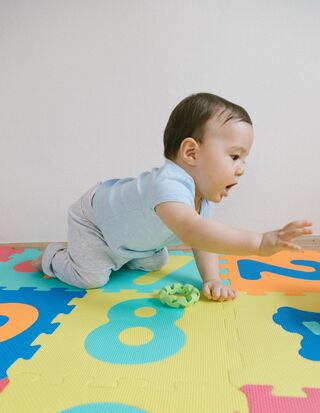Sleep
Does It Matter If Your Child Skips Crawling?
The research behind the development of crawling—or not.
Posted March 12, 2022 Reviewed by Tyler Woods
Key points
- The CDC recently made a controversial change to its developmental milestone checklists by removing crawling as a developmental milestone.
- Research suggests that crawling is important for development since it is the typical first type of independent locomotion.
- However, research has not consistently found any associations between skipping crawling and later developmental issues.
- Parents should only be concerned about a lack of crawling when it occurs without another type of independent locomotion or with other delays.
The Centers for Disease Control and Prevention (CDC) and the American Academy of Pediatrics (AAP) recently changed the developmental milestone checklists for the first time in 20 years. One of the most controversial changes was the removal of crawling as a developmental milestone. So does it matter if a baby crawls or not?
The average age that an infant begins crawling is 8.3 months. Research suggests that 85 to 96 percent of children crawl on their hands and knees.

Why Is Crawling Important?
Research finds that crawling is important for babies in learning risk perception (that is, determining whether a situation is safe or not). For example, a baby’s experience with crawling determines how likely they are to fall into a tub filled with water (while walking experience does not). Experience with crawling specifically may help infants to judge the difference between safe and unsafe surfaces.
The onset of crawling is also associated with improved spatial skills and more flexible memory abilities, as well as important differences in brain functioning. However, research also suggests that these developmental gains are likely due to crawling being the typical first type of independent locomotion and any type of independent locomotion (scooting, shuffling, walking, etc.) is likely to be associated with the same gains.
What If A Child Skips Crawling?
Many babies skip crawling and develop normally. Research estimates that 4 to 15 percent of babies do not crawl on their hands and knees. Some shuffle around on their bottoms, some "army crawl" on their stomachs, some roll, and others go straight to walking. Research finds that children who shuffle on their bottoms walk about a month later than children who crawled, with no differences for other forms of movement. Yet, children who skip crawling to go straight to walking may start walking at earlier ages than average.
Research also finds no association between a child’s pre-walking strategy (that is, whether they crawl or not) and later IQ or language development. A very small study found an association between skipping crawling and an inefficient pencil grasp in the future, however the researchers used a non-standardized measure of pencil grasp and an unclear definition of skipping crawling (for example, they categorized infants who crawled for less than two months in the group of infants who skipped crawling). Further research is needed to better understand this association.
Are Children More Likely to Skip Crawling Due to the "Back to Sleep" Movement?
Some research suggests that the “back to sleep” movement may be associated with delayed crawling. Specifically, research finds that babies who sleep more often on their stomachs tend to crawl at an earlier age than children who sleep more often on their backs. However, putting a child to sleep on their stomach may increase the risk of SIDS by as much as 12 times. In addition, babies who sleep frequently on their backs achieved crawling within normal limits and “catch up” in terms of motor development by 18 months. This research indicates that the benefits of the "back to sleep" movement outweigh the potential temporary delay in crawling. Further research also suggests that this potential delay may be avoided by encouraging "tummy time" during awake times.
Takeaway Message for Parents
Delayed crawling or skipping crawling is not typically a cause for concern. However, it may still be important as a developmental milestone since it is typically the first type of independent locomotion, and a lack of crawling without another type of locomotion or in the presence of other signs of delay could be a cause for concern. If your child is not crawling by 12 months and does not have another strategy for independent movement or shows other signs of delay, you should contact your pediatrician or early intervention services as soon as possible.
What Does This Research Suggest Parents Should Do?
- To encourage your child to crawl (or engage in any type of independent locomotion), use “tummy time” during play. Research finds that, when babies are placed more frequently on their tummies, they are more likely to crawl at earlier ages. Since infants typically do not prefer tummy time, try to make it fun for your infant by interacting with them, using highly desired toys, or doing tummy time on a caregiver's chest.
- Limit a child’s time in exersaucers, strollers, car seats, etc., as these devices restrict a child’s opportunities to practice independent movement. In particular, avoid using baby walkers, which research has found to delay the onset of crawling (and other motor milestones).
- Dress them in less restrictive clothing. Research finds that babies seem to learn to crawl earlier when they are around 6 months in the summer time, suggesting that restrictive clothing may impact the development of crawling.
- Continue putting your baby to sleep on their back. Sleeping on the back is unlikely to have negative impacts on crawling or other motor milestones and is associated with a dramatic reduction in the risk for SIDS.
- If your baby does not have a strategy for moving independently from one place to another by 12 months and/or is showing other signs of developmental delay, contact your pediatrician or local early intervention services as soon as possible.
References
WHO Multicentre Growth Reference Study Group, & de Onis, M. (2006). WHO Motor Development Study: windows of achievement for six gross motor development milestones. Acta paediatrica, 95, 86-95.
Størvold, G. V., Aarethun, K., & Bratberg, G. H. (2013). Age for onset of walking and prewalking strategies. Early human development, 89(9), 655-659.
Burnay, C., Cordovil, R., Button, C., Croft, J. L., & Anderson, D. I. (2021). Experienced crawlers avoid real and water drop‐offs, even when they are walking. Infancy, 26(5), 770-779.
Bai, D. L., & Bertenthal, B. I. (1992). Locomotor status and the development of spatial search skills. Child Development, 63(1), 215-226.
Kubicek, C., Jovanovic, B., & Schwarzer, G. (2017). The relation between crawling and 9-month-old infants’ visual prediction abilities in spatial object processing. Journal of experimental child psychology, 158, 64-76.
Herbert, J., Gross, J., & Hayne, H. (2007). Crawling is associated with more flexible memory retrieval by 9‐month‐old infants. Developmental Science, 10(2), 183-189.
Bell, M. A., & Fox, N. A. (1996). Crawling experience is related to changes in cortical organization during infancy: Evidence from EEG coherence. Developmental psychobiology, 29(7), 551-561.
Campos, J. J., Anderson, D. I., Barbu-Roth, M. A., Hubbard, E. M., Hertenstein, M. J., & Witherington, D. (2000). Travel broadens the mind. Infancy, 1(2), 149-219.
Robson, P. (1984). Prewalking locomotor movements and their use in predicting standing and walking. Child: care, health and development, 10(5), 317-330.
Bottos, M., Barba, B. D., Stefani, D., Pettenā, G., Tonin, C., & D'Este, A. (1989). Locomotor strategies preceding independent walking: prospective study of neurological and language development in 424 cases. Developmental Medicine & Child Neurology, 31(1), 25-34.
Visser, M. M., & Franzsen, D. (2010). The association of an omitted crawling milestone with pencil grasp and control in five-and six-year-old children. South African Journal of Occupational Therapy, 40(2), 19-23.
Davis, B. E., Moon, R. Y., Sachs, H. C., & Ottolini, M. C. (1998). Effects of sleep position on infant motor development. Pediatrics, 102(5), 1135-1140.
Task Force on Infant Sleep Position and Sudden Infant Death Syndrome. (2000). Changing concepts of sudden infant death syndrome: implications for infant sleeping environment and sleep position. Pediatrics, 105(3), 650-656.
Dewey, C., Fleming, P., Golding, J., & ALSPAC Study Team. (1998). Does the supine sleeping position have any adverse effects on the child? II. Development in the first 18 months. Pediatrics, 101(1), e5-e5.
Kuo, Y. L., Liao, H. F., Chen, P. C., Hsieh, W. S., & Hwang, A. W. (2008). The influence of wakeful prone positioning on motor development during the early life. Journal of Developmental & Behavioral Pediatrics, 29(5), 367-376.
Garrett, M., McElroy, A. M., & Staines, A. (2002). Locomotor milestones and babywalkers: cross sectional study. Bmj, 324(7352), 1494.
Bai, Y., Shang, G., Wang, L., Sun, Y., Osborn, A., & Rozelle, S. (2018). The relationship between birth season and early childhood development: Evidence from northwest rural China. PLoS One, 13(10), e0205281.


